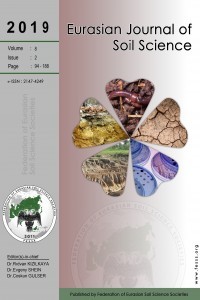
Eurasian Journal of Soil Science
Yazarlar: Emmanuel AMOAKWAH, Mohammad A. RAHMAN, Kwabena A. NKETİA, Rousseau DJOUAKA, Nataliia Oleksandrivna DİDENKO, Khandakar R. ISLAM
Konular:Fen
DOI:10.18393/ejss.843861
Anahtar Kelimeler:Soil degradation,Slush-burn agriculture,Carbon protection capacity,Minimum dataset,Soil quality
Özet: Deforestation for conventional farming has affected soil quality (SQ) worldwide. The goal of our study was to evaluate the impact of land use change, from forest to subsistence farming, on SQ in Benin. Composite soils from forest, horticultural, agricultural, fallow, and degraded lands were collected to analyze for chemical and physical properties. Using inductive additive approach and principal component analysis (PCA), generalized (SQIg) and minimum dataset SQ (SQIMDS) indices were calculated. Results showed that upon conversion of forest, total organic carbon (TOC) decreased by more than 2 folds in fallow and degraded soils. A similar impact was observed on total nitrogen (TN). Soil cation exchange capacity (CEC) and base saturation (BS) were significantly higher under horticulture than in degraded lands. In contrast, carbon protection capacity (CPC) was significantly higher by 12-41% in forest soils compared to the lowest in degraded soils. Among the land uses, aggregate stability index (ASI) was, by far, the lowest (3.2%) in degraded soils and highest (7.5%) in horticulture soils. Soils under fallow and degraded lands had SQIg decreased by 5 to 16%, when compared with forest, indicating a significant SQ degradation. In contrast, SQIg under horticulture increased by 5%, suggesting a similar or even an improvement in SQ comparable to the forest. The PCA-based SQIMDS significantly and positively accounted for 70% of the variability in SQIg with a non-significant biasness (6 ± 3.8% at p<0.12). The TOC and CPC contributed most (20.9% and 21.1%) followed by clay (14.1%) and Ca+2: (Mg+2 + K+1 + Na+) (13.7%), TOC (11%), and ASI (10.5%) compared to lowest by K+ (9.7%) to account for SQIMDS variability. Our results concluded that there was no significant difference between SQIg and SQIMDS, which justified our results to use SQIMDS detecting management-induced changes in SQ.